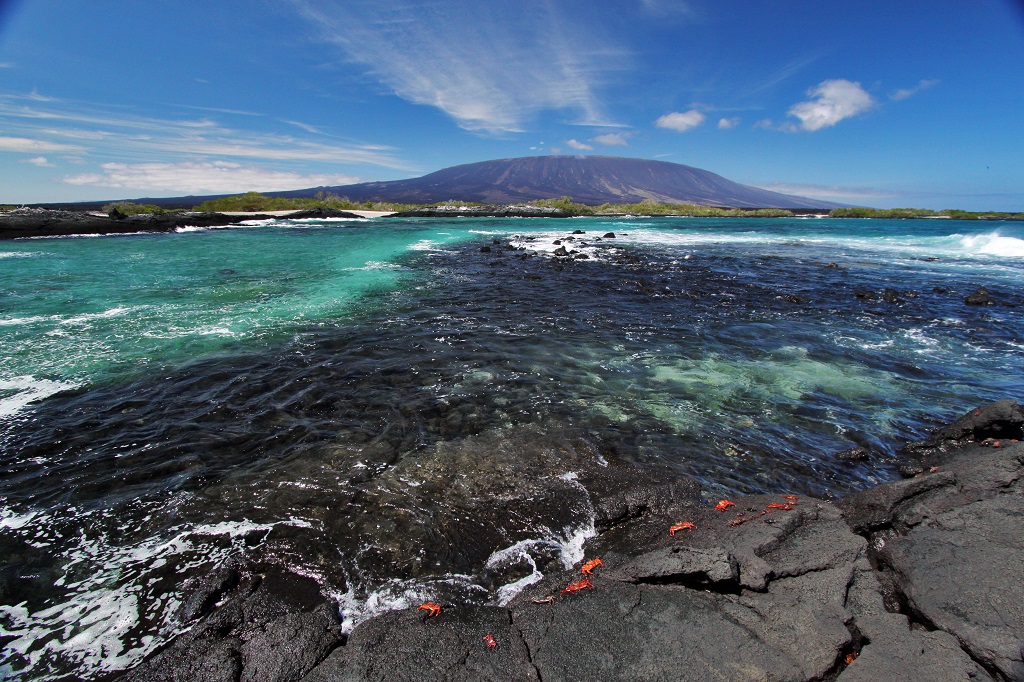
After 40 years of travel to the Galápagos, going back the islands still give me goose bumps. Today boats are nicer, with more comfortable cabins and posh food, good guides and additional activities like kayaks. The animals and landscapes are as beguiling as ever. The animals don’t fear humans and still offer the chance to get up close and personal. Planning a trip of a lifetime there is better with the help of experienced travel experts. I often get asked the same questions from travellers, so thought it would be useful to summarize these in an article.
1, Getting there – Flying to Galápagos

Unless you have your own boat, the only way to get there is to fly. The Galápagos lie on the Equator, 600 miles off the coast of Ecuador. There are no international flights to the Islands, you need to fly to Ecuador first, either Quito, up in the Andes, or the tropical port Guayaquil. Both Quito and Guayaquil are served from Europe (via Madrid, Amsterdam or Paris) and America from New York, Atlanta, Dallas, Houston and Miami. Other routes go via Central and South America including Bogota, Lima and Panama City. There are two main airports in Galápagos on the Islands of Baltra and San Cristobal.
We usually take care of booking Galápagos flights for our clients. The boats have spaces allocated to ensure passengers arrive on the right flight and the correct island! The flight takes under two hours (from Quito it can take longer with a stop in Guayaquil). Two airlines fly to Galápagos, LATAM and AVIANCA. All operate morning daily flights from Quito via Guayaquil to the islet of Baltra, where you can meet your cruise, or travel by ferry and overland to Puerto Ayora on Santa Cruz Island. There are also daily flights to San Cristobal Island. We recommend arriving in Ecuador 24-48 hours before your Galápagos flight in case of any delays. Galápagos cruise boats keep to a strict itinerary and will not wait if you miss your flight.
2, When To Go

You can visit the Galápagos all year, they are sub-tropical. Located astride the Equator they are cooled by currents. There are two seasons in the Galápagos, a hotter season from January to April with air temperatures from 22°- 30° C / 72 – 86° F (water temperatures up to 26° C / 79° F). Skies are clear, blue and with occasional rains. Sunny weather and calmer seas makes it best if you’re prone to seasickness (but air-conditioning a must). From May through December, the cool Humboldt current prevails, with air temperatures 19° – 26° C / 66° F making comfortable walking weather (water temperatures drop to 21° C / 70° F). The sea is rarely stormy, but trade winds cause the ocean to be choppier and a misty garua fog appears in the mornings. Divers may prefer the cool season as there is a chance to see whale sharks. For wildlife there is more activity between the two seasons: i.e. April-June or November-December. Avoid popular travel periods like July-August and Christmas and Easter when it gets booked up early.
3, Plan ahead

If you have a special date, or arranging a family trip, we recommend planning at least 9-12 months ahead and 1-2 years ahead for peak holiday travel like Christmas. If you are flexible, ask for our special deals, usually in the Autumn. It’s still a great time and many boats have great offers. Give us a call to ask about other discounts and check out our huge range of trips to the Galápagos. A trip to the Galápagos is a “trip-of-a-lifetime”, but with so much choice it is easy to be confused with all the yachts, islands and itineraries. I lived and worked in the Galápagos and have 40 years of travel experience so let me do the advising not some random website
4, Choosing the itinerary

When I first visited the islands 40 years ago, yachts could drop anchor where they pleased. Now boat routes are strictly regulated by the National Park. Each itinerary is designed to see as much of the landscapes and wildlife with minimum impact. If there is an animal that you really want to see, ask for an itinerary that includes it. In general, most boats do one week central and south-eastern islands and another to the northern and western, but some split weeks into shorter 4 or 5-day trips. The eastern islands are older, more eroded and forested and good for land birds and warmer for swimming. The western are younger, bigger volcanoes (still active) and have more spectacular scenery, but colder water. Any Galápagos trip is going to be amazing. Whether you want to see the unique endemic species, learn about pirates and whalers or enjoy botany, knowing what interests you will help find the perfect trip for you. With 13 main islands, there’s a lot of choice. Popular faves are the giant Galápagos tortoise, marine iguana, land iguana, the Galápagos penguin and flightless cormorant.
5, Choose your boat

The best way to see the Galápagos is aboard a boat for a few days. Cruise yachts travel at night, so you’ll wake up at a new site each day. To choose the best yacht, we’ll need to know your style, budget, and interests. Bigger boats suit a range of budgets, motor yachts are more spacious and luxurious, and the sailing yachts have a great ambience. Some yachts are more appropriate for families, with triple cabins, child discounts or interconnecting cabins. Many vessels carry kayaks and snorkelling kit. Look for a yacht that offers plenty of space outdoors with shade. The best yachts have plenty of open space to relax in and give the choice of eating al fresco.
If you are prone to motion sickness, you may feel nauseous on longer navigations but most time is spent in calm waters. So, don’t be put off a voyage. We can advise when weather is calmer (November – June) or find a yacht and cabin that will minimalize the movement. There has been much debate about mono-hulls versus catamarans and in general larger boats move less than very small ones. On the other hand a smaller boat means that less time is spent ferrying passengers to and from the islands, and the guides will let you linger longer if something interesting happens. You won’t have to queue up to go for a snorkel.
For those with limited mobility or very small children, there are eco-lodges on the beaches or in highlands, with day trips to nearby islands. However, we feel the rapid growth of hotel-based tourism is not a good thing for the islands. It is not as controlled as boat-based tourism and is unsustainable.
6, How long a trip?

Cruises range from 4 days / 3 nights to 15 days / 14 nights, with the most popular options being 5-day, 8-day and 11-day cruises. It is important to choose the right cruise length for you. On all cruises you will see some Galápagos wildlife, longer cruises give you the chance of seeing more species and see more islands. The 4-day cruises are the most cost-effective (although are a little too short) and give a taste of the Galápagos, and often combined with a holiday elsewhere in South America (e.g. Peru). If Galápagos is the priority, an 8-day cruise is long enough to see a good range of islands. However, if you really want to see as many endemic species as possible, then consider an 11-day or 15-day option.
7, Cost

A week in the Galápagos can cost anywhere from £3,600 per person on a large ship to £6,900 on a small luxury yacht. Somewhere in the mid-range still allows for more intimate motor yacht style with excellent service and top-notch naturalist guides. If you’re going all the way to the Galápagos, stay on the best quality vessel your budget allows. Though there comes a point when you are paying for linen tablecloths and waiters with white gloves which will not enhance the wildlife experience. Most of the time is spent walking onshore, snorkelling with sealions or sitting on deck watching the sunset. The time spent in an air-conditioned luxury cabin is mainly to sleep. It is better to spend the money on a longer cruise in a more modest vessel.
8, Entry requirements

No visas are required for US or UK citizens to travel to Ecuador or the Galápagos. However, you should check your passport to be sure the expiration date is at least 6 months after your departure date from Ecuador. If you don’t have at least that amount of time left on your passport, you will need to renew it before your trip. You will not require any special vaccinations for the Galápagos although we always urge travellers to consult their physician for anything that may be specific to your own medical history.
9, Trip Insurance

Trip Insurance is required for many of the boats in the Galápagos and is highly recommended anytime you travel, especially to remote areas. Check that emergency medical repatriation and trip cancellation insurance in covered. The Galápagos is a big investment and so you should protect it.
10, Family Travel

Galápagos is a fantastic place to take children. If travelling with youngsters we can offer special family departures, which are available during the peak summer and holiday months. These trips focus on bringing families on the same vessels with children around the same age. The naturalist guides will be chosen for their empathy with kids and will both entertain and educate. Some boats include special menus and films, games and activities to keep youngsters occupied for the evening.
11, Naturalist Guides

The naturalist guide can make a trip into something really special. They are an essential part of a good Galápagos trip. To go ashore or snorkel in the water you’ll always be with a specially trained naturalist guide. A good guide is a communicator and knows how to share the wonders of the unique islands and wildlife. Guides are trained by the scientists of the National Park but employed by the boat owners. We recommend boats that employ the highest category, who have the required academic level as well as the course required by the Galápagos National Park. They have mastered at least 2 languages (usually English is the most desired), often with years of experience and up to date license.
12, Why book with Select Latin America?
Select Latin America grew from Galápagos Adventure Tours, the first UK company to specialise in cruises and adventure tours to the Galápagos 35 years ago. We have a long association with the archipelago. The founder David Horwell was a licensed naturalist guide and lived there over 40 years ago. He volunteered with conservation work after his guiding came to an end. David and the company have supported the Galápagos Conservation Trust for more than two decades. He also travels frequently to the islands to ensure we’re offering you the best trips. We are members of the Latin American Travel Association and receive regular updates on the safety and services of yachts we offer. We work with a selection of first-class, smaller yachts which offer our travellers a personal, safe and comfortable experience. Our boats are accompanied by the best licensed naturalist guides. We help you can choose the right trip based on your preferred departure dates, style and budget.
View our holiday ideas.
Related: A Typical Day in the Galapagos Islands
8 Incredible Things You’ll Do on a Galapagos Cruise
Like what you read in this blog? Talk to our travel expert to plan your dream trip to South America
Send message
